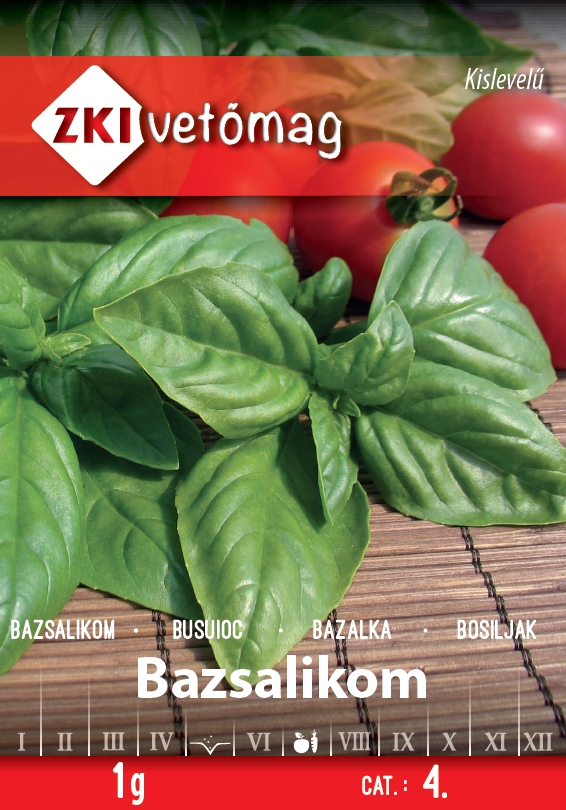Basil small leaf 1g ZKI
| €1.14 * (nettó: €0.90) | |
BASIL - SMALL LEAF
Annual ornamental, spice and medicinal plant. The main root of the taproot branches into numerous lateral roots. It does not penetrate deeply, but its dense branching penetrates a relatively large layer of soil. It is rigidly erect. 40-60 cm long stems branch from the rootstock into many lateral shoots. Stems, typical of the lip family, are rectangular. Several varieties are distributed according to stem length, leaf shape and colour. In most places the green-coloured and small-leaved variety is grown. There is very little hairiness around the veins on the stem and leaf bracts. The ovate leaves have a lacy or indented edge, short petiole and rounded shoulders. The pattern of veins is faintly visible on the bare, thin leaf blade.
Environmental requirements
Basil is one of our most heat-demanding herbs. Seed germination requires temperatures of 18-22 °C. They germinate at 10-15 °C, but at this temperature germination is slow and uneven. A temperature of 20 °C or above is required for the plant to grow. Its heat requirements are very close to those of peppers. It is sensitive to frost, and even severe colds will stunt its growth. The last harvest should be timed to take place before the slightest ground frost, otherwise quality will deteriorate. It needs a lot of warmth during its growing season. In rainy, cool summers, less essential oil accumulates in it.
Light requirements
It needs a lot of light. It grows poorly in shade or partial shade, produces few flowers and becomes worthless. It therefore needs not only warmth but also plenty of sunshine to flower.
Needs water:
Due to the uneven rainfall distribution in Hungary, it can only be grown safely by irrigation. It requires 550-600 mm of water during its growing season. Favourable yields can be expected when the soil is 60-65% saturated. It is best if this water capacity is maintained at all times, or at least at germination, during periods of intensive shoot growth and flowering. Without irrigation it will be poor quality and stunted.
Soil requirements
It does not require a deep layer of soil to grow because its root system is located close to the surface. Do not experiment with planting in extreme soil types (quicksand, silt, stony soil). It also grows sluggishly in strongly bound, clayey areas. Loose-textured, sandy loam soils are ideal. Choose a site that is easy to warm. In deep, waterlogged areas, the plant will not grow in sufficient water, as the slow warming will inhibit its growth.
Nutrient requirements
Choose a site with good water management and high nutrient levels. It does not require fresh organic fertilisation and is rotated in the second or third year after the application of manure.For every 10m2 of high humus area, apply 35-40 dkg of lime putty, 40-50 dkg of superphosphate and 30-40 dkg of potash. The phosphorus and potassium fertilisers are applied in the autumn and the nitrogen fertilisers are applied two or three times during the growing season as head manure. Foliar fertilisation is also a good way of replenishing micro-nutrients.
Growing basil
Because of its heat requirements, it can only be propagated in our country by seedling cultivation. Until mid- to late May, you can use overwintering or short-lived plants to make the most of the area.
Soil preparation
The autumn soil preparation (ploughing, digging, fertilising) should be adapted to the possible two-year use. If you do not have a previous crop, leave the soil in a large mound after the autumn tillage to collect as much winter rainfall as possible. In the spring, leave the partially decomposed clumps to be straightened out for the last time and keep them weed-free until planting.
Sowing
Sow the seeds under plastic film towards the end of March. Spread the small seeds on the surface and cover with 1 cm of peat or sand. Sow in rows 10-15 cm apart or scattered. During slow emergence, the bedding may become clumpy. Remove weeds from the start. Keep the temperature around 20°C during seedling establishment. As the seedlings grow, increase the number and duration of daily aerations. Watering should be adapted to the outside temperature and sunshine.
Space
Plant out the 8-10 cm seedlings one by one or two by two in the open ground after the May frosts. Before planting, it is very important to train the small plants by constant aeration and drainage to acclimatise them to the outside environment. Water the bed thoroughly before picking up, so that the seedlings can be lifted with as little root damage as possible. Plant the plants at a row spacing of 40-50 cm and a stake spacing of 20-25 cm. Immediately after transplanting, water the soil thoroughly and soak the roots.
Watering
Alternate watering and hoeing during the growing season. Head water before watering, first at planting, then at the beginning of budding and after the first cut. Nutrients can be added at each watering. For a better effect, do not mix the pre-spread fertiliser with the soil, but water it as a nutrient solution.
Other growing options
In recent years, the use of direct, open-air planting has replaced seedling growing. By the end of April, the top layer of soil has warmed up enough to allow the seeds to be sown. Its seeds are very small, weighing 1,5-1,7 g per thousand seeds, and are sown at a depth of no more than 1 cm. Compact the soil by rolling after sowing. The seed requirement is 3 to 4 gper 10m2, but bear in mind that the seeds will only germinate for 2 to 3 years.
After germination, of course, the number of plants should be adjusted, leaving 6-8 plants per linear metre. The rest of the care is the same as for the seedlings, except that the restored ones are much more drought tolerant.
They can also be grown in pots or balcony boxes. With its pleasant fragrance and continuous flowering, it is a nice colourful addition to the urban home and a constant source of fresh spices for the kitchen.
Pests
No pathogens or pests, no plant protection required.
Harvest
Can be harvested twice a year. (It is not worth experimenting with open field harvesting, apart from its heat tolerance, because it can only be cut once.) In July, when the first flowers appear, cut with sickles, leaving a 10 cm stalk. The second cut is made in September, before the early frosts. The cut shoots should be transported to the dryer (shed, shed) without being crushed. Dry them in a dry, airy, shady place, spread out thinly on a rattle and then crumble the leaves off the thicker stems, together with the young shoots.
Use
Its cultivation and use in warm climate countries dates back thousands of years. It was once grown almost everywhere in village houses to keep flies away. Its pleasant, interesting smell is hard for flies to tolerate. Above ground, it accumulates 0.5-1% essential oil, of which the main constituent, about half, is methyl cavicol, with eugenol and estragole also present.
In addition to essential oil, the green parts of the plant contain significant amounts of vitamin C. In folk medicine, it is used as an appetite stimulant, diuretic, diaphoretic and cough suppressant. Its decoction is also used externally as a poultice and as a gargle for sore throats. It is a very popular spice in southern Europe: it is used to flavour soups, stews, sauces and meat dishes. Like most herbs, it can be grown in winter near the windows of a heated home. Keep it warm and as much light as possible. If watered regularly, it will develop a more vigorous bushy stem if the incipient inflorescence is pinched.
Throwing its fresh leaves into a tea infusion gives a very pleasant aroma. Its green leaves can also be used in winter to flavour salads, pizza, egg dishes or soft drinks and liqueurs. With its continuous flowering, it is a good bee-keeper, decorative and can also be planted as an ornamental.
| Weight: | 0.001 kg |
|---|---|
| Width: | 1 mm |
| Height: | 110 mm |
| Length: | 150 mm |
| Aviability: | 1-4 nap |
| Basic sales unit: | db |
Login
Login

